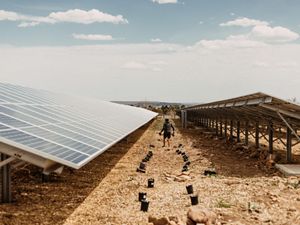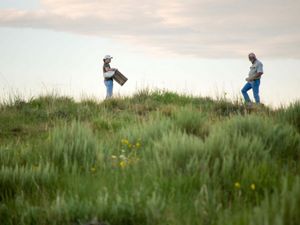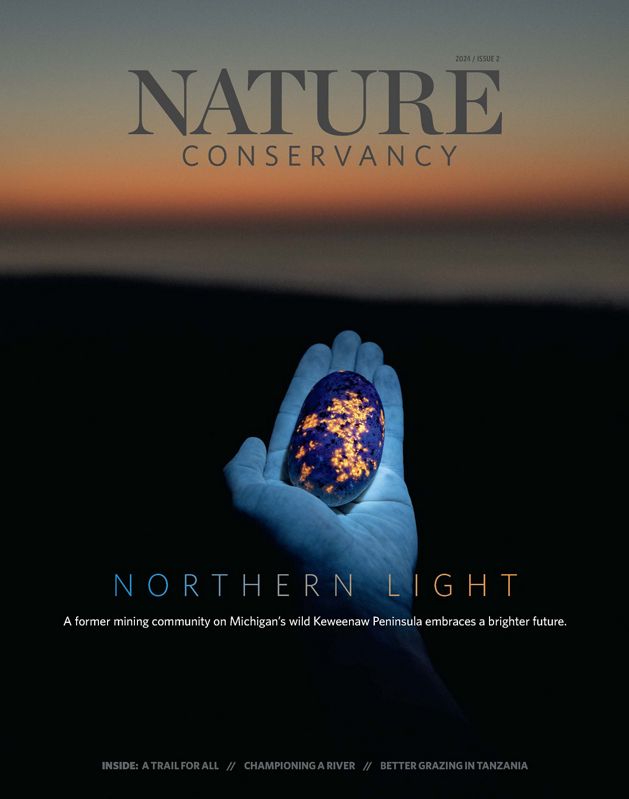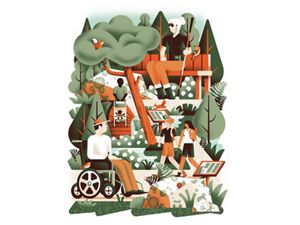
Farming the Sun
In Colorado, we are learning how it’s possible to harvest more than just electricity on a solar farm.
Text by Duncan Gilchrist | Photographs by Joanna Kulesza | Issue 2, 2024
Just south of Longmont, Colorado, in the sun-drenched foothills of the Front Range, is a small but bustling family-owned farm. On an average summer day at Jack’s Solar Garden, people growing spinach, sage and strawberries mingle with students studying sustainable food production, as bees and other pollinators hum around flowers.
For all its lushness at ground level, from a bird’s-eye view the five acres that make up Jack’s Solar Garden are partially covered by dark glass. That’s because of the 3,276 photovoltaic panels on-site, which together generate 1.2 megawatts, enough to power about 300 homes.
This type of combination of produce and solar panels is called agrivoltaics, a relatively new and exciting idea that can provide ecological, economic and community benefits in addition to clean energy. Agrivoltaics could also be part of the solution to one of the most pressing issues facing our efforts to transition to clean energy: how to build electrical capacity while minimizing loss of farmlands and harm to ecosystems in the process.

To meet the challenge of climate change, we need more renewables—fast. This means building out clean energy infrastructure—primarily wind and solar—as quickly as possible. The Nature Conservancy’s “Power of Place” report estimates that the United States will need to generate between 3,100 and 3,500 gigawatts of clean energy to reach a target of net-zero emissions by 2050.
Economically, this is possible: Federal incentives and technology breakthroughs have made clean energy more viable every year. But industrial-scale clean power generation will require a lot of terrestrial acreage. According to some estimates, it will take over 250,000 square miles of land—roughly the size of Colorado and Montana put together—to support enough solar and wind generation to meet our goals.
That’s a huge footprint, and it poses a significant threat to natural areas. How can we reduce the sprawl of clean energy? And is it possible to improve land already claimed for power generation? The Nature Conservancy’s climate priorities, such as its Natural Climate Solutions strategy, include protecting, managing and restoring nature to reduce greenhouse gas emissions and store carbon. One key is identifying suitable locations for renewables that minimize biodiversity loss and habitat disruption. That’s why, in 2022, we developed the Site Renewables Right map, which aims to help energy developers identify sites where renewable energy can be developed while avoiding important wildlife habitat.
Quote
After only a year, the project showed that we can grow a variety of crops under a solar array that wasn’t originally designed for planting, even if the site is in bad shape to start.
Good Energy
Byron Kominek, shown at left with Alexa Hapgood, turned 5 acres of his family’s hay field into Jack’s Solar Garden—a functioning farm and agrivoltaic research site. Lessons learned at this farm are being shared via tours and education programs hosted by the nonprofit Colorado Agrivoltaic Learning Center, which Kominek co-founded in 2020.





Farm + Solar: Byron Kominek, owner and manager of Jack’s Solar Garden, and Alexa Hapgood. © Joanna Kulesza

Farm and Learn: The working farm at Jack's Solar Garden is also a research and outreach facility © Joanna Kulesza

Grassland Study: Matthew Sturchio, a PhD student at Colorado State University, studies the health and functions of grassland ecosystems within a solar array. © Joanna Kulesza

Lined Up: The solar field at Jack’s Solar Garden was designed with agriculture in mind. © Joanna Kulesza
That tool helps protect wildlands. But what about supporting farming productivity on sites that are well suited for solar? And is it possible to retrofit these sites to not only generate clean energy but also improve biodiversity? Agrivoltaics can be an excellent example of that in practice, since it can boost clean energy production and benefit nature at the same time. The shade provided by the panels helps plants retain carbon and water, which helps increase crop yields and carbon sequestration, and selecting plants carefully can lead to richer soil and greater biodiversity. Research has shown that solar farms can increase wildlife diversity by providing shade and shelter for native perennials. The idea of agrivoltaics has been around for decades, but its adoption is still in the early stages in the U.S., where there are only a handful of commercial solar-crop sites.
Of these, Jack’s Solar Garden is probably the most successful example. Specifically designed as an agrivoltaics farm, Jack’s has turned out over 25,000 pounds of veggies, herbs and berries since 2021, thanks in large part to the efforts of the urban agriculture nonprofit Sprout City Farms. The property also includes a large section of pollinator habitat established by Audubon Rockies and hosts research, education and sustainable food production projects. It’s no surprise that Jack’s is the most visited solar array in the country.
Can agrivoltaics restore soil health and biodiversity?
Businesses like Jack’s prove that agrivoltaics can work when solar fields are designed to coexist with farming. But what about retrofitting commercial solar operations that weren’t built with agriculture in mind? Many solar projects have been built on degraded or barren lands. The odds of growing anything around these sites appear slim at best, but what if it could work?
To test this idea, TNC recently led a pilot project at a small solar array owned by Boulder Housing Partners (the city’s affordable housing agency), about 10 miles southwest of Jack’s, dedicated to offsetting energy for low-income residents. The half-acre pilot site sits on rocky, degraded soil left over from the array’s construction. With funding from TNC’s Catalyst Fund, a conservation initiative in Colorado that supports forward-looking projects, TNC assembled a diverse group of partners in 2022 to see if the site could be brought back to life. Our goals were threefold: demonstrate the added value offered by agrivoltaics, improve the soil health and biodiversity of the site, and provide a benefit to community members living in the city’s affordable housing.
Byron Kominek, owner and manager of Jack’s Solar Garden, provided advice on best practices, while Drylands Agroecology Research (DAR), a regenerative agriculture collective, took on the task of preparing the site for planting. The sandy soil didn’t hold moisture well, and it was so rocky that many of the columns holding the solar panels had to be mounted on concrete. To improve the soil, DAR dug basins to retain and distribute rainfall and brought in 150 cubic yards of compost and wood chips to spread over the site.
The Conservancy consulted with local business WishGarden Herbs and the University of Colorado’s Foundations for Leaders Organizing for Water and Sustainability program to help decide which plants to grow. Choosing perennials instead of annuals would ensure that the garden wouldn’t have to be replanted every year. It was important to incorporate species that would grow well, but also ones that had cultural significance and medicinal and economic value. They couldn’t be more than about 2 feet high or they would interfere with the solar panels—and, ideally, they wouldn’t be too tasty for the local prairie dogs.
The eventual list included 30 different perennial species, such as fringe sage, scarlet globe mallow, native flax, woods rose and comfrey. Volunteer planting days helped build relationships with the local community.
We wanted our project to deliver tangible benefits to the local community members who live in affordable housing. We provided a number of paid opportunities and workshops that brought community members out to the site to help implement the vision of the project.
Early results show success, but there’s a lot more to learn
One year into the project, over 83% of the plants had survived, which is especially encouraging considering perennial species can take a few years to establish their roots. (The only ones that didn’t do very well were coneflowers, which seemed to be a prairie dog favorite.) Insect biodiversity increased, with surveys showing more predators and pollinators.
After only a year, the Agrivoltaics Retrofit Partnership project showed that we can grow a variety of crops under a solar array that wasn’t originally designed for planting, even if the site is in bad shape to start. Done right, agrivoltaics can support local ecosystems while helping us meet future clean energy requirements.
As we build more and more solar fields, we need to think more creatively about this infrastructure and the land it occupies: not as a sacrifice, but as something than can actually catalyze ecosystem regeneration. Many solar farms have the potential to be dual-use lands in the future.
The idea of agrivoltaics can seem obvious, but it isn’t a one-size-fits-all solution. Farmers and developers in the U.S. are exploring its potential—experimenting with which forms of solar construction fit best with which kinds of agriculture, as well as grazing, pollination or some combination of the above. A setup that works on a fruit and vegetable farm in Colorado might not fit a cornfield in Iowa.
Workable business models are also just starting to come together. Developers are under intense pressure from utilities to build the most cost-effective solar energy projects possible. Agrivoltaics challenges the traditional mindset of purely focusing on cost and energy production. Instead, it considers broader values like conservation, agriculture and community well-being. So it’s not just about cheap electricity; it’s about creating a sustainable and harmonious system.
Now is the time to think critically about how we can deploy clean energy infrastructure in ways that are compatible with ecosystems and communities, and how we can create policies that enable and encourage progress. Already, the Agrivoltaics Retrofit Partnership project has led to major policy advancements in Colorado: TNC leveraged the partnerships and insights from the project to help pass a bipartisan state bill that allocated $1 million over two years toward agrivoltaics research and demonstration projects.
With careful planning and robust community engagement, we have the potential to transform thousands of parcels of land—otherwise forgotten under photovoltaic arrays—into spaces that not only produce clean energy but provide agricultural, ecological and cultural benefits. Even small investments of time and money can bloom into large-scale, transformative change.
About the Creators
Duncan Gilchrist is a climate and natural resources policy associate for TNC in Colorado. He spearheaded the organization’s agrivoltaic project in Boulder and used this experience to help create state-level bipartisan legislation in 2023.
Joanna Kulesza is an editorial, documentary and fine art photographer living near Denver, Colorado. Her photos have appeared in The Economist, Vogue and NPR.










